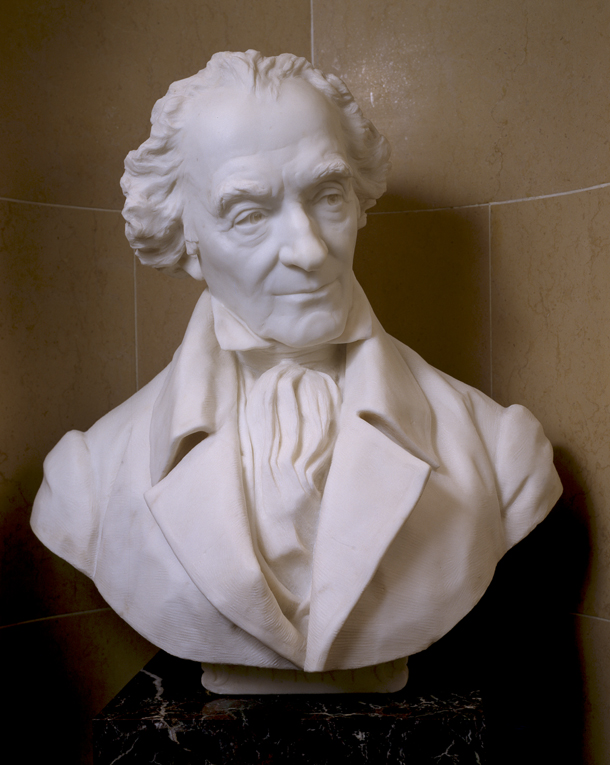
| Title | Elbridge Gerry |
| Artist/Maker | Herbert Samuel Adams ( 1858 - 1945 ) |
| Date | 1892 (carved), 1891/1892 (modeled) |
| Medium | Marble |
| Dimensions | h. 32.5 x w. 28 x d. 18.25 in. (h. 82.6 x w. 71.1 x d. 46.4 cm) |
| Credit Line | U.S. Senate Collection |
| Accession Number | 22.00005.000 |
The bust of Vice President Elbridge Gerry was among the second group of works ordered by the Senate as part of the Vice Presidential Bust Collection for the Senate Chamber. The commission was initially offered to sculptor Thomas Ball, who turned it down because of prior commitments. Herbert Adams–-now considered one of the great American sculptors of the late 19th century–-was then approached. In his early thirties at the time, he was already recognized for portrait busts, with honorable mentions awarded to him at the 1888 French Salon and at the 1889 Universal Exposition. Though born in Vermont, Adams was a longtime Massachusetts resident. He thus suited the Senate’s effort to secure sculptors from vice presidents’ home states. Adams accepted the commission, creating first a clay model and then a plaster cast that was translated into marble in Paris and finished by the artist at his studio. The completed bust was placed in the Senate Chamber in July 1892.
The portrait is, of course, posthumous, but it is logical to assume that Adams intended to depict Gerry as vice president–-that is, between the ages of 68 and 70. If the sculptor knew that Gerry was in very poor health during his tenure (with a shrunken, skeletal appearance, according to a contemporary), Adams understandably ignored that fact. Despite his decrepitude, Gerry loved society, and his charm and fine manners made him a favorite of the capital’s hostesses, Dolley Madison among them. Indeed, by most accounts his “relentless socializing” contributed to his debility.
Adams presumably read descriptions of Gerry’s personality, as well as accounts of the vice president’s political ideals and activities. Certainly, this likeness is remarkable for its congeniality. As viewers, we are treated to a witty, charming face. His head cocked slightly forward and to the side, Gerry looks to his left with eyebrows raised as though listening to a pleasant companion. We seem included in this intimate society because Adams has made the height of the head the same as that of the torso, producing the effect of a close-up. The deeply drilled pupils enhance the impression of animation and intelligence.
Recently returned from five years in Paris, where he studied and worked in the atelier of the then-famous and highly accomplished academic sculptor Antonin Mercié, Adams had learned his trade thoroughly. The marble bust of Gerry is fluently carved, with no fussing over detail. The flowing cravat and remarkably deep undercutting of the proper left coat lapel lend tactility and immediacy. Adams requested and received a viewing of the intended location for the bust in a corner niche of the Senate gallery. He must have used this knowledge to his advantage by turning Gerry’s head away from the corner in this natural, communicative pose.
In addition to the Gerry bust, Adams is remembered for completing the bronze doors of the Jefferson Building of the Library of Congress (left unfinished at the death of sculptor Olin Warner) and for a figural bronze fountain for McMillan Reservoir Park in Washington, D.C. Other notable works by the artist include statues of William Ellery Channing in Boston, William Cullen Bryant at Bryant Park in New York City, and John Marshall at the Cleveland Courthouse.
Elbridge Gerry, who was born in Marblehead, Massachusetts, was a U.S. representative and the fifth vice president of the United States. He originally joined the family mercantile and shipping business, and later became involved in anti-British activity. He supported the revolutionary activist Samuel Adams and served as a member of the Massachusetts Committee of Correspondence, the first and second Provincial Congresses, and the Committee of Safety. In 1776 Gerry was elected as a member of the second Continental Congress, a position he held almost continuously for 10 years. He signed both the Declaration of Independence and the Articles of Confederation. As a delegate to the Constitutional Convention of 1787, Gerry feared an overly powerful central government and refused to sign the new federal Constitution. Following the document's ratification, however, he pledged his support.
Gerry was elected to the U.S. Congress in 1789 and served for two terms. He ran for governor of Massachusetts several times before winning the election of 1810. During his term, Gerry oversaw a politically motivated restructuring of state voting districts, which disproportionately benefited his party. His opponents published cartoon figures of a salamander-shaped election district and coined the term "Gerrymandering." Thus Gerry's name was forever linked with the practice of creating an irregularly shaped district through partisan maneuvers.
As James Madison's running mate for his second term, Gerry was elected vice president of the United States in 1812. A supporter of the War of 1812 and a loyal ally of the president, Gerry defended the administration during the controversies of wartime even as his health began to fail. He died in office in November 1814 and was buried at Congressional Cemetery in Washington, D.C. A lavish monument, designed by New York sculptors William and John Frazee, was erected there in his memory.